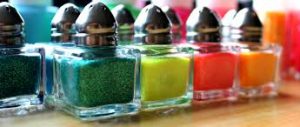 It’s usually difficult to know exactly what ingredients are in our nail polishes, because the print is so small on those little bottles of beautiful colour. Even if we could read the ingredients for most people the list of chemicals are unpronounceable, and will mean very little without doing extensive research. However, it is important to understand that there are many toxic chemicals in most nail polishes that could do you harm. This can include Dibutyl Phthalate (a hormone disruptor and can cause reproductive issues), Formaldehyde (human Carcinogen), Toluene (skin and respiratory irritant and can effect the nervous system), Triphenl phosphate or TPHP (hormone disruptor, effects metabolism & may contribute to weight gain and cause developmental and reproductive problems), and many others.
It’s usually difficult to know exactly what ingredients are in our nail polishes, because the print is so small on those little bottles of beautiful colour. Even if we could read the ingredients for most people the list of chemicals are unpronounceable, and will mean very little without doing extensive research. However, it is important to understand that there are many toxic chemicals in most nail polishes that could do you harm. This can include Dibutyl Phthalate (a hormone disruptor and can cause reproductive issues), Formaldehyde (human Carcinogen), Toluene (skin and respiratory irritant and can effect the nervous system), Triphenl phosphate or TPHP (hormone disruptor, effects metabolism & may contribute to weight gain and cause developmental and reproductive problems), and many others.
Although there are some mainstream brands now cutting out some of these harmful chemicals, usually it’s just two or three. There are still only a small handful that are taking all of these chemicals, and their health impacts seriously. For example, there are not many that don’t have Triphenl Phospate (TPHP). A study conducted by the Environmental Working Group in the US and Duke University found that all women in the study group who had painted their nails had the metabolite of TPHP (Diphenyl phosphate or DPHP) in their bodies within a very short period of painting their nails. This including some women who had used nail polishes claiming not to have TPHP in their ingredients.
Additionally, it is thought that due to increased awareness of the issues around Phthalates, companies are just replacing those chemicals with TPHP, which can do a similar job as a plasticiser and in making nail polish flexible and durable.
IT’S IMPORTANT TO BEWARE OF NAIL POLISHES CLAIMING TO HAVE REMOVED HARMFUL CHEMICALS, AS IT HAS BEEN FOUND THAT THIS MAY NOT HAVE BEEN THE CASE.
It is obviously very concerning that these products are marketed to women, and in particular to young girls and women who’s bodies are developing and potentially entering puberty. It’s important to understand what is in nail polishes in order to avoid these harmful chemicals:
- Make sure there are no Pthalates of any kind, no Toluene and no Formaldehyde as these are some of the most harmful; also referred to as the “toxic 3”.
- Ideally you also want to exclude formaldehyde resin, ethyl tosylamide, xylene, Triphenyl Phosphtte and camphor
There are a number of brands now that exclude these chemicals and are usually sold at health food stores.
This is what you can do to make low toxic nail polish choices:
- Don’t use nail polishes – instead buff nails to make them shiny. Also eating a healthy diet that includes eggs, salmon, avocado, nuts, seeds, green vegetables and lots of other vegetables and fruit; will result in healthy looking nails.
- Keeping the polish off the cuticle and surrounding skin is believed to minimise skin absorption.
- Use low tox options – There are now brands producing nail polishes with “3 free” to “8 free” ingredients. The best option is obviously anything saying they are 8 free, or if you’re unsure then go online to find their safety data sheet or ring the company directly to find out the ingredients. 8 Free nail polishes should be free from triphenyl phosphate, xylene, toluene, formaldehyde, DBP, formaldehyde resin, camphor and ethyl tosylamide. The products that promote 3 Free will only be free of Dibutyl Phthalate, Toluene and Formaldehyde. I don’t believe this is enough.
- Also use non-toxic nail polish removers if you can find them, and use the same methods to determine the ingredients. Some of the low tox nail polishes can be removed by soaking in warm water and scraping off, therefore there’s no need for a remover.
- Dispose of old products you no longer want to use in a responsible way, as most of these chemicals are also extremely damaging to the environment as well as human health.
I’m a qualified Building Biologist, Nutritionist and Feng Shui practitioner. Identifying chemicals such as these in your home whether they be from personal care products or other contaminants is just one area that I look at when auditing a home or workplace. If you would like to find out more please contact me.

Leave a Reply